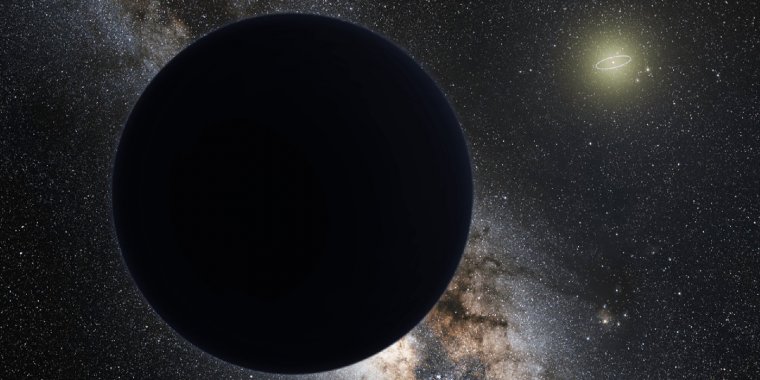| News / Science News |
The Super-Earth that Came Home for Dinner
It might be lingering bashfully on the icy outer edges of our solar system, hiding in the dark, but subtly pulling strings behind the scenes: stretching out the orbits of distant bodies, perhaps even tilting the entire solar system to one side.

An artist's illustration of a possible ninth planet in our solar system. Neptune's orbit is shown as a bright ring around the Sun. Image Credit: ESO/Tom Ruen/nagualdesign
If a planet is there, it's extremely distant and will stay that way (with no chance -- in case you're wondering -- of ever colliding with Earth, or bringing "days of darkness"). It is a possible "Planet Nine" -- a world perhaps 10 times the mass of Earth and 20 times farther from the sun than Neptune.
The signs so far are indirect, mainly its gravitational footprints, but that adds up to a compelling case nonetheless.
"There are now five different lines of observational evidence pointing to the existence of Planet Nine," said Konstantin Batygin, a planetary astrophysicist at Caltech in Pasadena, California, whose team may be closing in. "If you were to remove this explanation and imagine Planet Nine does not exist, then you generate more problems than you solve. All of a sudden, you have five different puzzles, and you must come up with five different theories to explain them."
Six known objects in the distant Kuiper Belt, a region of icy bodies stretching from Neptune outward toward interstellar space, all have elliptical orbits pointing in the same direction. That would be unlikely -- and suspicious -- enough. But these orbits also are tilted the same way, about 30 degrees "downward" compared to the pancake-like plane within which the planets orbit the sun.
Computer simulations of the solar system with Planet Nine included show there should be more objects tilted with respect to the solar plane. In fact, the tilt would be on the order of 90 degrees, as if the plane of the solar system and these objects formed an "X" when viewed edge-on. Five such objects already known to astronomers fill the bill.
The last telltale sign of Planet Nine's presence involves the solar system's contrarians: objects from the Kuiper Belt that orbit in the opposite direction from everything else in the solar system. Planet Nine's orbital influence would explain why these bodies from the distant Kuiper Belt end up "polluting" the inner Kuiper Belt.
But where did Planet Nine come from? Batygin says he spends little time ruminating on its origin -- whether it is a fugitive from our own solar system or, just maybe, a wandering rogue planet captured by the sun's gravity.
"I think Planet Nine's detection will tell us something about its origin," he said. (NASA)
YOU MAY ALSO LIKE



